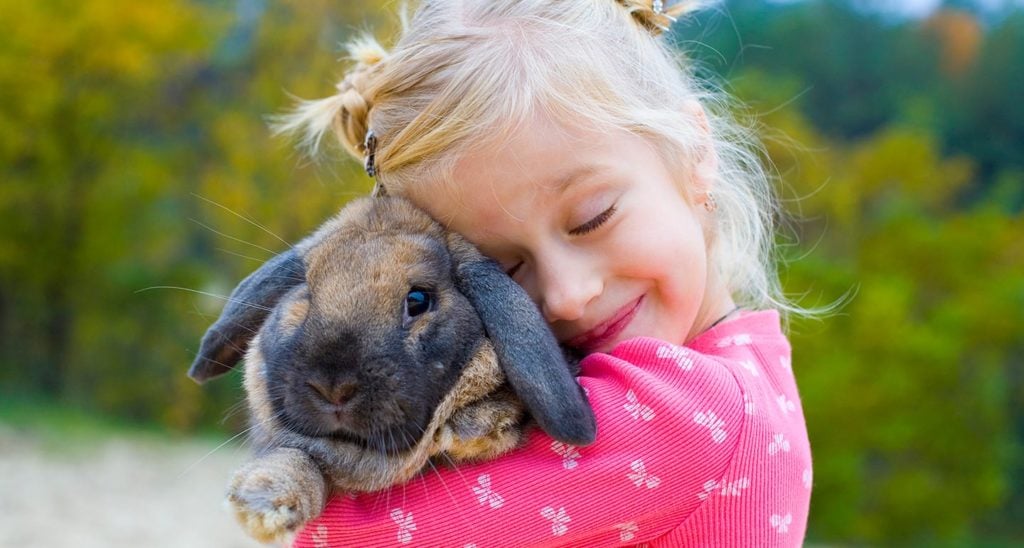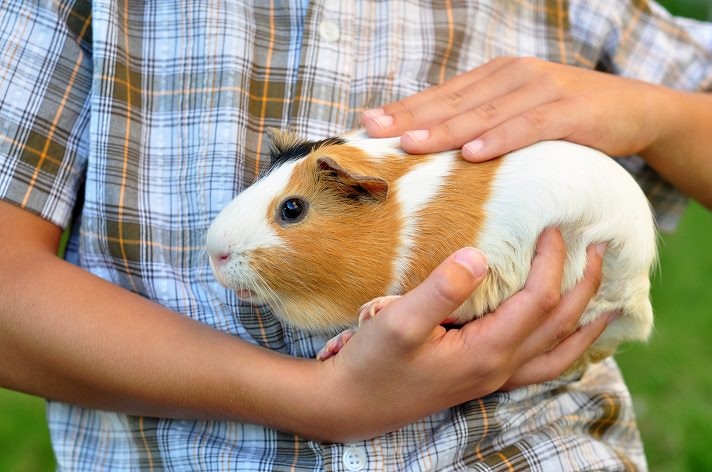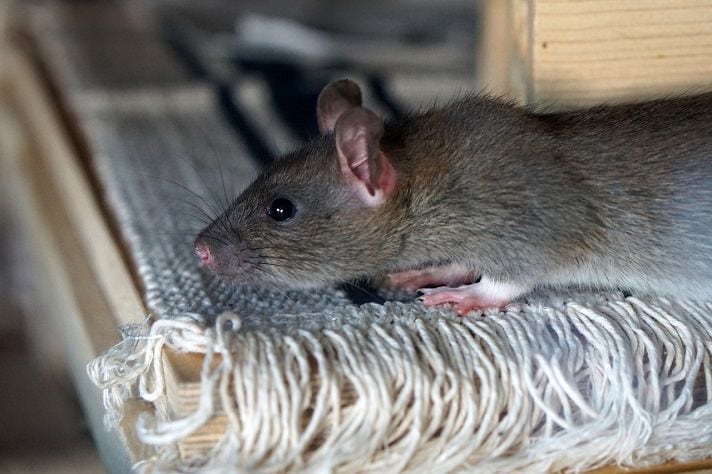Some small animal pets are more kid-friendly than others. The success or failure of getting a “pocket pet” for a child depends on the choice made by you or your child of which small animal pet to get. Life span, interactions, grooming needs and etc. all combine to make each pet species unique.
According to the American Pet Products Association 2011-2012 survey, the top eight small pets are rabbits, hamsters, guinea pigs, mice/rats, gerbils, chinchillas and ferrets. Here’s a quick review of each species’ child-friendly pet potential.
1. Rabbits

via DjelicS
Soft and furry rabbits are available in many breeds, with more than 60 rabbit breeds recognized by the American Rabbit Breeders Association. The large selection of rabbit breeds and availability make rabbits a popular children’s pet. Holland Lops, Dutch and Polish are some of the popular bunny breeds, and larger bunny breeds like the Flemish Giant tend to be more tolerant of handling.
Although life spans vary, rabbits generally live for about 10 years, which means getting a pet rabbit is a significant commitment. If a child is 10 when a young bunny joins the family, he or she will likely be a high school graduate or beyond for the bunny’s senior years.
Rabbits are social animals that generally do best when paired or grouped with other rabbits, but be sure that all rabbits are neutered or spayed to avoid unintended breeding.
Rabbits generally do not like to be held or picked up; incorrect handling can result in a rabbit’s nails scratching a child, or a rabbit’s back or legs being injured or broken.
Since rabbits groom themselves, shorthaired breeds usually don’t need owners to do much beyond a weekly brushing and spot-cleaning of fur. Rabbits do require regular nail trims, especially if they do not have access to appropriate digging opportunities, and they must have items to chew on in addition to hay to keep their teeth trimmed. Rabbits with maloccluded teeth might need regular tooth trims done by a veterinarian. Long-haired rabbit breeds usually require daily brushing. Rabbits can be litter-trained.
Special note: Rabbits absolutely must eat hay, so a rabbit won’t be a good fit if anyone in the house is allergic to hay.
Lifetime Commitment: High
Needs A Companion: High
Likes To Be Held: Low
Grooming: Low for shorthaired breeds; high for longhaired breeds
2. Hamsters
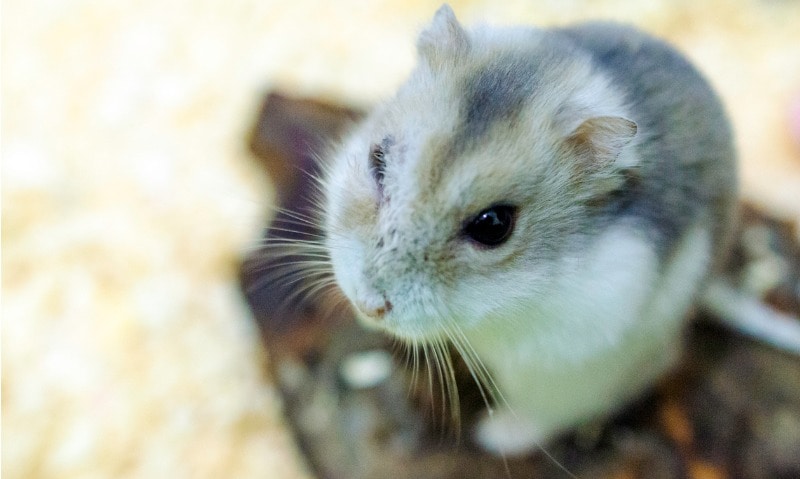
iStock.com/golibo
The charming, busy hamster is a pet that’s fun to watch. Five species are usually available—the large Syrian and the four smaller dwarf species: Roborovski, Winter White, Campbell’s and Chinese.
The life span of hamsters ranges from one to three years, with the Syrian living longest. The Syrian must always be kept in its own habitat, because adult Syrians usually fight, sometimes to the death. The dwarf breeds can do well in groups, but might occasionally get into fights that require housing them in separate habitats. Pair or group same-sex hamsters to avoid breeding.
While hamsters don’t usually object to being held, they usually won’t sit and cuddle. Hamsters are the busy bees of the pet world and are usually on the go. It’s most fun to watch them play in their habitat or in a play area.
One drawback to hamsters is their sleep schedule, which is the opposite of a child’s. Hamsters are awake and busy at night and sleep during the day.
Hamsters are self-groomers that rarely need an owner to do anything except provide an occasional dust bath with the special dust sold by pet retailers. As rodents, hamsters have constantly growing teeth that are kept in check by them chewing appropriate hamster food or toys.
Special note: Chinese hamsters are illegal to own in some states.
Lifetime Commitment: Low
Needs A Companion: Low
Likes To Be Held: Low
Grooming: Low
3. Guinea Pigs
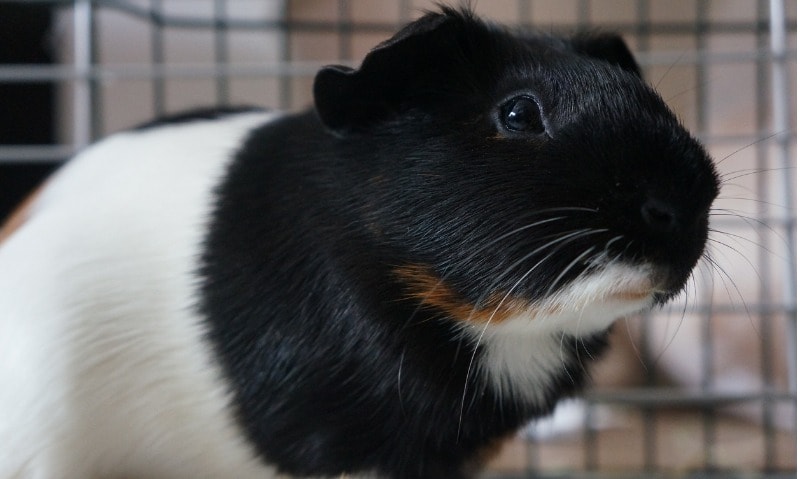
via iStock.com/Shwartau
The endearing guinea pig is a herd animal that enjoys interacting with its owner. Often, guinea pigs request food by wheeking, making a high-pitched, drawn-out squeak.
The American Cavy Association recognizes 13 guinea pig breeds, so there’s some variety to choose from. Guinea pigs typically live for about five years.
As a herd animal, they do best paired with another guinea pig, but some do well alone if an owner is attentive. If males are not neutered, same-sex pairs or groups are needed to avoid breeding.
Guinea pigs will generally be content when held securely for a few minutes. Hold a guinea pig while seated with it resting on a towel or small animal bed. Although it’s fun to sit with a guinea pig, one drawback is that they urinate or defecate frequently, so be prepared for some accidents.
Grooming needs for shorthaired breeds include occasional brushing and spot-cleaning of fur and regular nail trims. Long-haired breeds need more frequent brushing. Guinea pigs keep their growing teeth trim by chewing appropriate guinea pig food or toys.
Special note: Guinea pigs must eat hay, so a guinea pig won’t be a good fit if anyone in the house is allergic to hay.
Lifetime Commitment: Medium
Needs A Companion: High
Likes To Be Held: Medium
Grooming: Low for shorthaired breeds; high for longhaired breeds
4. Mice And Rats
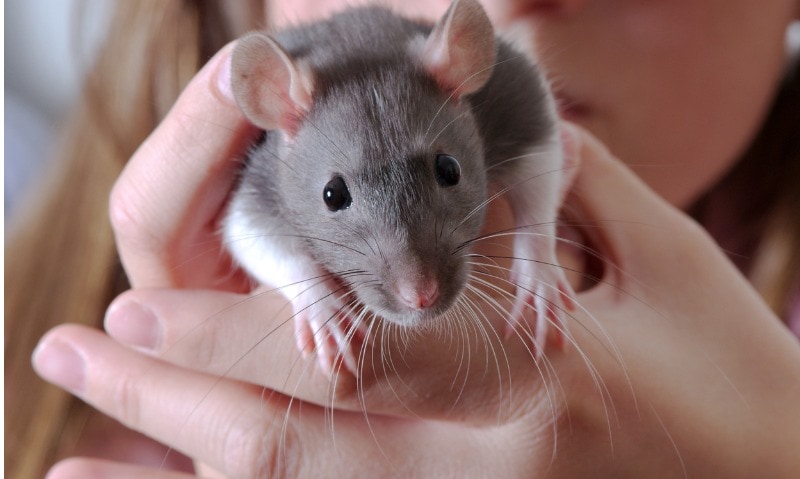
via iStock.com/dlHunter
Rats might top the list as a kid-friendly pet. With only a two to three year life span, the time commitment is low. Mice have even less of a time commitment, living only one to two years.
Both rats and mice are social animals and do better in same-sex pairs or groups; the exception is male adult mice, which will fight if housed together.
Rats enjoy interacting with owners and like to hang out together, which is why they make a kid-friendly pet.
Their size is about right for children—not too small, but easy to pick up and carry. Mice are much smaller than rats and are more like hamsters regarding interaction. That means mice often enjoy doing their own thing and are more fun to watch than hold.
Grooming for both rats and mice is minimal, because both pets groom themselves. Owners might need to brush or spot-clean the coat occasionally.
Chew items must be provided to keep their growing teeth trimmed.
Lifetime Commitment: Low (1 to 2 years for mice; 2 to 3 years for rats)
Needs A Companion: Medium to High
Likes To Be Held: Low (mice); High (rats)
Grooming: Low
5. Gerbils
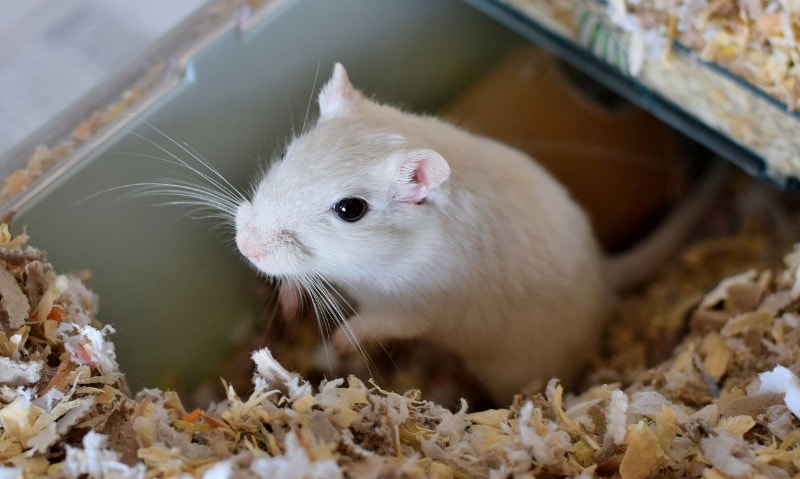
via iStock.com/Pictureview
The playful gerbil is busy, smart and likes to hang out with people.
Although gerbils only live for about two to three years, they pack a lot of living into that time.
Acrobatic and social, gerbils usually do best if housed as same-sex pairs/groups. Occasionally, gerbils might need separate housing if fighting occurs.
With gentle handling, gerbils learn to trust their owner and enjoy interacting. A gerbil should never be lifted by its tail, because the tail skin might come off and never return.
Gerbils are another self-grooming pet and do not require regular grooming from their owner. However, gerbil owners should offer a dust bath to the gerbils weekly and always provide items for the gerbils to chew to keep their ever-growing teeth trimmed. Gerbils are known for their chewing ability!
Special note: Gerbils are illegal to own in several states, so be sure your area permits gerbil ownership before obtaining one.
Lifetime Commitment: Low
Needs A Companion: High
Likes To Be Held: Medium
Grooming: Low
6. Chinchillas
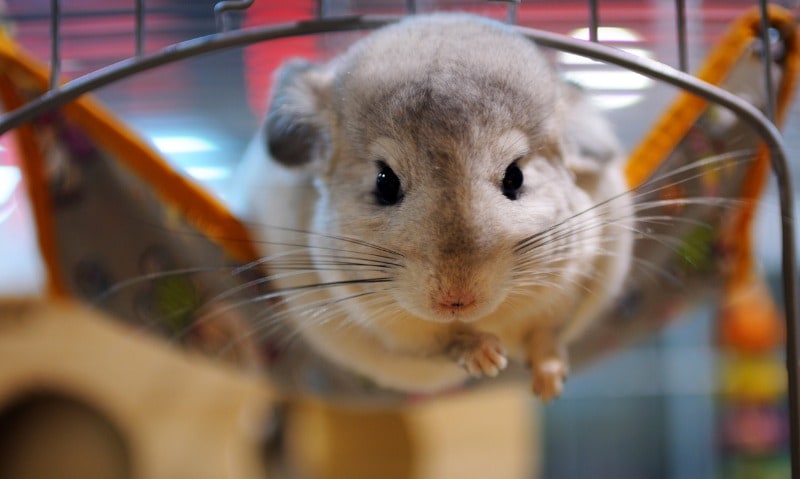
via iStock.com/PhotoTalk
Touching a chinchilla’s super-soft fur is a sensation, but chinchillas rarely hold still for petting. Chinchillas live to be about 10 years old. They are on the large side of the small animal pets and require a larger cage.
As herd animals, they do best with a companion chinchilla (same-sex to avoid breeding). Chinchillas, like hamsters and mice, are pets more to appreciate by watching instead of interacting with them. Handling can be difficult, and grabbing the fur wrong can cause it to come out in clumps.
Grooming for a healthy chinchilla basically requires just offering it a dust bath a few times a week.
Chinchillas also like to chew and have constantly growing teeth, so appropriate chew items must be provided to keep their teeth trimmed.
Special note: Chinchillas must eat hay, so a chinchilla won’t be a good fit if anyone in the house is allergic to hay.
Lifetime Commitment: High
Needs A Companion: High
Likes To Be Held: Low
Grooming: Low
7. Ferrets
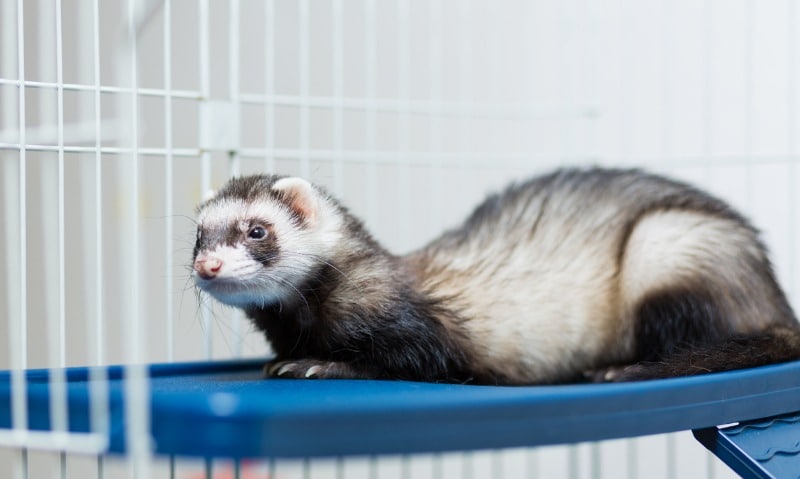
via iStock.com/FaST_9
The ever-curious ferret is a furry ball of energy when awake and a limp ragdoll when asleep. Ferrets live for about five to seven years and are full of personality. Some are shy, while others are rough-and-tumble characters.
Ferrets should be neutered or live in same-sex pairs/groups. A ferret can be kept as a single pet as long as the owner is attentive. All ferrets require a few hours of out-of-cage playtime or free-roam of a ferret-proofed room. Most ferrets won’t mind being held but typically prefer to be off exploring.
Grooming needs are a bit higher than other small animal pets because, in addition to regular nails trims and occasional coat brushing or baths, ferrets need regular tooth brushing. Ferrets can be litter-trained.
Special note: Young ferrets are known to go through a nippy phase, and the hammocks or sleep sacks ferrets need must be laundered at least weekly.
Lifetime Commitment: Medium
Needs A Companion: Medium
Likes To Be Held: Medium
Grooming: Medium to High
Is Your Child Ready For A Small Animal Pet?
In general, children less than 7 years old should always be supervised around a small animal pet that is outside its habitat. Responsibility for feeding the pet, cleaning its habitat and looking after its needs should not solely be a child’s responsibility. An adult must oversee the small animal pet’s care.
By: Marylou Zarbock
Featured Image: via Serafima/iStock/Thinkstock
Share:
